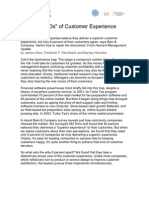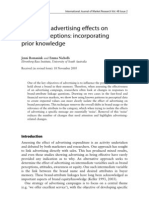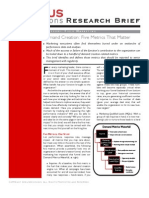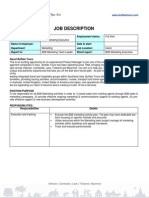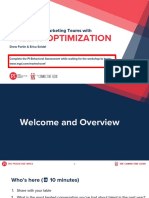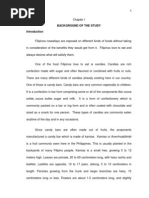0 ratings0% found this document useful (0 votes)
81 viewsKPIs For A CMO
KPIs For A CMO
Uploaded by
Anonymous qn0rOBpLTThe key priorities for a CMO are to increase customer acquisition, grow the brand, improve marketing campaign efficiency, and increase customer retention and repeat purchases. Additional objectives include improving the customer experience to increase customer lifetime value. Key performance indicators used to measure success include customer acquisition cost, return on advertising spend, audience insights to improve targeting, customer satisfaction score, net promoter score, hit rate, and various metrics related to customer service response times and escalation rates.
Copyright:
© All Rights Reserved
Available Formats
Download as DOCX, PDF, TXT or read online from Scribd
KPIs For A CMO
KPIs For A CMO
Uploaded by
Anonymous qn0rOBpLT0 ratings0% found this document useful (0 votes)
81 views2 pagesThe key priorities for a CMO are to increase customer acquisition, grow the brand, improve marketing campaign efficiency, and increase customer retention and repeat purchases. Additional objectives include improving the customer experience to increase customer lifetime value. Key performance indicators used to measure success include customer acquisition cost, return on advertising spend, audience insights to improve targeting, customer satisfaction score, net promoter score, hit rate, and various metrics related to customer service response times and escalation rates.
Original Description:
KPIs for a CMO
Original Title
KPIs for a CMO
Copyright
© © All Rights Reserved
Available Formats
DOCX, PDF, TXT or read online from Scribd
Share this document
Did you find this document useful?
Is this content inappropriate?
The key priorities for a CMO are to increase customer acquisition, grow the brand, improve marketing campaign efficiency, and increase customer retention and repeat purchases. Additional objectives include improving the customer experience to increase customer lifetime value. Key performance indicators used to measure success include customer acquisition cost, return on advertising spend, audience insights to improve targeting, customer satisfaction score, net promoter score, hit rate, and various metrics related to customer service response times and escalation rates.
Copyright:
© All Rights Reserved
Available Formats
Download as DOCX, PDF, TXT or read online from Scribd
Download as docx, pdf, or txt
0 ratings0% found this document useful (0 votes)
81 views2 pagesKPIs For A CMO
KPIs For A CMO
Uploaded by
Anonymous qn0rOBpLTThe key priorities for a CMO are to increase customer acquisition, grow the brand, improve marketing campaign efficiency, and increase customer retention and repeat purchases. Additional objectives include improving the customer experience to increase customer lifetime value. Key performance indicators used to measure success include customer acquisition cost, return on advertising spend, audience insights to improve targeting, customer satisfaction score, net promoter score, hit rate, and various metrics related to customer service response times and escalation rates.
Copyright:
© All Rights Reserved
Available Formats
Download as DOCX, PDF, TXT or read online from Scribd
Download as docx, pdf, or txt
You are on page 1of 2
KPIs for a CMO
CMO’s main Objectives:
Increase customer acquisition
Grow brand – no of visits during a period
Improve the efficiency of marketing campaigns
Customer retention: increase repeat purchase
improve customer experience and service: Customer Lifetime Value(Customer revenue
minus the costs of acquiring and serving the customer)
Customer acquisition- top priority, amount of marketing spends divided by the number of
customers acquired through these marketing efforts- the cost for acquiring one customer
Analysing marketing Campaigns
Measure Revenue generation- how much of the marketing efforts (and budget) has actually
translated into revenues. How effective the marketing strategy was.
Return on Advertising Spend (ROAS) is the amount of revenue a company receives
for every dollar spent on an advertising source. This is a gauge of the effectiveness
of online advertising campaigns.
Audience Insights for Improved Targeting:
Stay on top of your customer identity. Use customer demographics to learn about your
buyers and improve the targeting of your marketing campaigns.
Customer service analysis
Customer satisfaction (CSAT) score: The CSAT KPI is typically measured by customer
responses to a very common survey question: “How satisfied were you with your
experience?” This is usually answered with a numbered scale.
Net promoter score (NPS): Your NPS KPI provides insight into your customer
relationships and loyalty by telling you how likely customers are to recommend your
brand to someone in their network.
Hit rate: Calculate your hit rate by taking the total number of sales of a single
product and dividing it by the number of customers who have contacted your
customer service team about said product.
Customer service email/call/chat count: This is the number of emails/call/chat your
customer support team receives.
First response time: First response time is the average amount of time it takes a
customer to receive the first response to their query. Aim low!
Average resolution time: This is the amount of time it takes for a customer support
issue to be resolved, starting from the point at which the customer reached out
about the problem.
Service escalation rate: The service escalation rate KPI tells you how many times a
customer has asked a customer service representative to redirect them to a
supervisor or other senior employee. You want to keep this number low.
You might also like
- Exploration of Gamification in Loyalty Programs For Consumer LoyaltyDocument12 pagesExploration of Gamification in Loyalty Programs For Consumer LoyaltyvxdddqoutbfnhjejuuNo ratings yet
- Precision Marketing - E-BookDocument17 pagesPrecision Marketing - E-BookAnonymous w3lOfkNo ratings yet
- Keyword Research ChemistryDocument21 pagesKeyword Research ChemistryFakhar JamilNo ratings yet
- Barbra Gago's Cover LetterDocument1 pageBarbra Gago's Cover LetterBarbraGago100% (1)
- KFC New Product PlanDocument28 pagesKFC New Product Planlucky zee94% (32)
- Audit of PpeDocument19 pagesAudit of PpeLiezel Laborte0% (1)
- Fueling The Revenue Engine:: 5 Strategies For Building and Feeding A Marketing MachineDocument9 pagesFueling The Revenue Engine:: 5 Strategies For Building and Feeding A Marketing Machineankitrathod87No ratings yet
- The Three D's of Costumer ExperienceDocument7 pagesThe Three D's of Costumer ExperienceJose Fernando Torres MesaNo ratings yet
- Ad and Brand PerceptionDocument15 pagesAd and Brand Perceptionirenek100% (1)
- Demand Creation Five Metrics That MatterDocument2 pagesDemand Creation Five Metrics That MatterIan GoldsmidNo ratings yet
- The B2B Executive Playbook: Achieving Sustainable, Predictable, Profitable GrowthDocument21 pagesThe B2B Executive Playbook: Achieving Sustainable, Predictable, Profitable GrowthSasi KumarNo ratings yet
- Segments of One Customer Insights in Digital BankingDocument28 pagesSegments of One Customer Insights in Digital BankingAshraf Uz ZamanNo ratings yet
- CMO Survey 2020Document33 pagesCMO Survey 2020Giridhar NairNo ratings yet
- SCM in B2BDocument11 pagesSCM in B2Brakshaksinghai100% (1)
- HBS Introduces Marketing Analysis Tools For ManagersDocument7 pagesHBS Introduces Marketing Analysis Tools For ManagersHem UpretiNo ratings yet
- Program Plan For B2B Marketers MarketoDocument20 pagesProgram Plan For B2B Marketers MarketoCan CananNo ratings yet
- Hyperlocal Marketing - What It Is, Why It Works, & How To Do It Right - WordStreaDocument30 pagesHyperlocal Marketing - What It Is, Why It Works, & How To Do It Right - WordStreaSaniya MunirNo ratings yet
- Digital Marketing Plan Template 0Document6 pagesDigital Marketing Plan Template 0omar FaisalNo ratings yet
- JD B2B Marketing Executive PDFDocument2 pagesJD B2B Marketing Executive PDFHuongHanNo ratings yet
- Segmenting, Targeting, Positioning: "The Error of STP Implementation in Sportindo Store Purwokerto"Document8 pagesSegmenting, Targeting, Positioning: "The Error of STP Implementation in Sportindo Store Purwokerto"Kaye Rousette CapinlacNo ratings yet
- BCG Retail 2020Document19 pagesBCG Retail 2020Edithmar TilleroNo ratings yet
- Prepare To Launch: Social Media Campaign Brief (Template)Document6 pagesPrepare To Launch: Social Media Campaign Brief (Template)LKMs HUBNo ratings yet
- Driving Value With Marketing Automation Best Practices GuideDocument22 pagesDriving Value With Marketing Automation Best Practices GuideDemand MetricNo ratings yet
- B2B Brand ArchitectureDocument2 pagesB2B Brand ArchitectureVenkataramanan VaidyanathanNo ratings yet
- 5 Unique Ways To Increase Customer Retention (And Increase Profits!)Document13 pages5 Unique Ways To Increase Customer Retention (And Increase Profits!)ManasiNo ratings yet
- AdWords Content NetworkDocument7 pagesAdWords Content NetworkAbad MarketingNo ratings yet
- The Lead Nurturing: 5 Reasons You Can't Ignore Lead Nurturing 10 Fundamentals For Your SuccessDocument6 pagesThe Lead Nurturing: 5 Reasons You Can't Ignore Lead Nurturing 10 Fundamentals For Your SuccessppppacoooooNo ratings yet
- Presentation 1Document16 pagesPresentation 1ranjithaNo ratings yet
- Lead Nurturing A Multi Touch Journey Exec SummaryDocument7 pagesLead Nurturing A Multi Touch Journey Exec Summaryjdweck364No ratings yet
- Brand LoyaltyDocument25 pagesBrand LoyaltyParesh ShindeNo ratings yet
- Applying The Rossiter-Percy Grid To Online Advertising Planning - The Role of Product - Brand Type in Previsit IntentionsDocument9 pagesApplying The Rossiter-Percy Grid To Online Advertising Planning - The Role of Product - Brand Type in Previsit Intentionsa861108No ratings yet
- Tuning Into The Voice of CustomersDocument2 pagesTuning Into The Voice of CustomersAninda DuttaNo ratings yet
- Sales Ops Best Practices: 28 Tips to Help You Optimize for SuccessFrom EverandSales Ops Best Practices: 28 Tips to Help You Optimize for SuccessNo ratings yet
- D365UG Customer InsightsDocument27 pagesD365UG Customer InsightsAsh 666100% (1)
- Federico Cesconi CEM FrameworkDocument30 pagesFederico Cesconi CEM FrameworkMaurizio Battelli100% (1)
- HP Channel StrategyDocument8 pagesHP Channel StrategyMdFarukHossain0% (1)
- B2B Marketing Attribution: The Cmo'S Guide ToDocument23 pagesB2B Marketing Attribution: The Cmo'S Guide ToArunNo ratings yet
- REPORT PFL Multichannel Marketing - V8Document41 pagesREPORT PFL Multichannel Marketing - V8Demand MetricNo ratings yet
- Brand Perception Unveiled: Building Brand Associations That ResonateFrom EverandBrand Perception Unveiled: Building Brand Associations That ResonateNo ratings yet
- Customer Marketing PDFDocument19 pagesCustomer Marketing PDFOthman RahmounNo ratings yet
- DE TO Ective D Rati: A GUI EFF LEA Gene ONDocument9 pagesDE TO Ective D Rati: A GUI EFF LEA Gene ONzooeyNo ratings yet
- A10 Guide Download WebDocument48 pagesA10 Guide Download WebClaudiu ȘuleaNo ratings yet
- Mobile Marketing EbookDocument21 pagesMobile Marketing EbookdeltonbaiduNo ratings yet
- A Marketing Analytics Framework For CMOsDocument6 pagesA Marketing Analytics Framework For CMOsRafael LemusNo ratings yet
- APN31 - J1 - The State of Customer Experience Technologies and - 336793Document43 pagesAPN31 - J1 - The State of Customer Experience Technologies and - 336793Nutan KaramchetiNo ratings yet
- LOYALTY INSIGHTS 2 Creating A Reliable MetricDocument8 pagesLOYALTY INSIGHTS 2 Creating A Reliable MetricElvira007No ratings yet
- BMW Advertising StrategyDocument24 pagesBMW Advertising StrategyDilipKumarSharma100% (5)
- Peppers Rogers Customer Experience in Retail Banking ArticleDocument30 pagesPeppers Rogers Customer Experience in Retail Banking ArticleSameer_Khan_60No ratings yet
- Current Issue and MarketingDocument5 pagesCurrent Issue and Marketingzuraidah hashimNo ratings yet
- Dark Side of Relationship MarketingDocument5 pagesDark Side of Relationship MarketingAbhishek KhandelwalNo ratings yet
- Competitive Positioning - Profile Your MarketDocument17 pagesCompetitive Positioning - Profile Your Marketwww.GrowthPanel.com100% (8)
- OroCommerce Guide To Customer Adoption FinalDocument11 pagesOroCommerce Guide To Customer Adoption FinalNitesh LaguriNo ratings yet
- Building A Badass Marketing Teams - MarTechConf WorkshopDocument72 pagesBuilding A Badass Marketing Teams - MarTechConf WorkshopR100% (1)
- BA7203 Marketing ManagementDocument10 pagesBA7203 Marketing ManagementRanjithNo ratings yet
- Definitive Guide To Sales Enablement v02r01Document56 pagesDefinitive Guide To Sales Enablement v02r01Petar DalipagicNo ratings yet
- Agency Brief Template - B2BDocument7 pagesAgency Brief Template - B2BEmily PhilippouNo ratings yet
- Part Two: Supply and Demand I: How Markets WorkDocument42 pagesPart Two: Supply and Demand I: How Markets WorkAlexander QuemadaNo ratings yet
- Activity 3 Exercise 1: ST ND RD TH TH TH TH TH TH TH TH THDocument7 pagesActivity 3 Exercise 1: ST ND RD TH TH TH TH TH TH TH TH THKervin Rey JacksonNo ratings yet
- Chapter 1 6Document79 pagesChapter 1 6Shundei Otawara100% (1)
- ETF Architect Overview VFDocument25 pagesETF Architect Overview VFgmkdigitalmediaNo ratings yet
- Flare Fragrances Co.: Section D, Group 7Document7 pagesFlare Fragrances Co.: Section D, Group 7rev1202No ratings yet
- S Ramachandra-Marketers Dont Build Brands Consumers DoDocument10 pagesS Ramachandra-Marketers Dont Build Brands Consumers Domaheshwari_pallavNo ratings yet
- Managerial Finance AssignmentDocument21 pagesManagerial Finance AssignmentPrashikshan UlakNo ratings yet
- bản phụ hp4Document86 pagesbản phụ hp4Đặng Hiểu NghiNo ratings yet
- ProtineX+Case+Study AssignmentDocument13 pagesProtineX+Case+Study AssignmentNishanth VNo ratings yet
- Study On Consumer Behaviour Towards Investment in JewelleryDocument43 pagesStudy On Consumer Behaviour Towards Investment in JewelleryRizwana HaseebNo ratings yet
- PDF26 2Document182 pagesPDF26 2Issac EbbuNo ratings yet
- Send Money Fees As of Nov 2020Document2 pagesSend Money Fees As of Nov 2020Krystal NapoNo ratings yet
- World: Umbrellas - Market Report. Analysis and Forecast To 2020Document9 pagesWorld: Umbrellas - Market Report. Analysis and Forecast To 2020IndexBox Marketing0% (1)
- SWOT Analysis of NCELL Company: - Suman PokharelDocument5 pagesSWOT Analysis of NCELL Company: - Suman Pokharelaashika shresthaNo ratings yet
- 3.01 Key TermsDocument17 pages3.01 Key Termsapi-262218593No ratings yet
- M Business 5th Edition Ferrell Test Bank 1Document51 pagesM Business 5th Edition Ferrell Test Bank 1carrie100% (61)
- Audio Duplication SystemDocument10 pagesAudio Duplication SystemPatrick Smith100% (2)
- Chapter 5. Job-Based Structures and Jobevaluation: Defining Job Evaluation: Content, Value, Andexternal Market LinksDocument1 pageChapter 5. Job-Based Structures and Jobevaluation: Defining Job Evaluation: Content, Value, Andexternal Market LinksSalahuddin BadhonNo ratings yet
- Did You Know - Air BNB - Anuj YadavDocument8 pagesDid You Know - Air BNB - Anuj YadavRitika SharmaNo ratings yet
- Generation & Screening of Project IdeasDocument28 pagesGeneration & Screening of Project IdeasVineet Maheshwari100% (1)
- Regd SDS/By PostDocument3 pagesRegd SDS/By PostJatinder SinghNo ratings yet
- IPO Performance Report - Q4 2021 FINALDocument11 pagesIPO Performance Report - Q4 2021 FINALSassi BaltiNo ratings yet
- BAC1Document2 pagesBAC1Aigeli Pearl ManlutacNo ratings yet
- Reasons For The Internationalization of CompaniesDocument11 pagesReasons For The Internationalization of CompaniesGeorgina-Mirela DanNo ratings yet
- Promotion Opportunity AnalysisDocument31 pagesPromotion Opportunity AnalysisRaja TomerNo ratings yet
- Puma PypDocument20 pagesPuma PypPrashanshaBahetiNo ratings yet
- Aice Business FinalDocument1 pageAice Business Finalapi-734293563No ratings yet
- Simran Khuran - InvestmentDocument3 pagesSimran Khuran - InvestmentSimran Kaur KhuranaNo ratings yet







